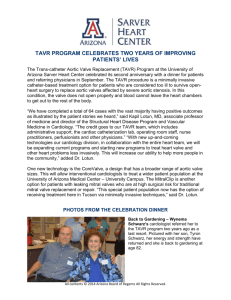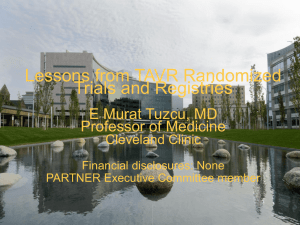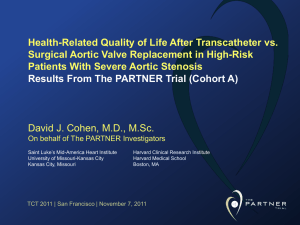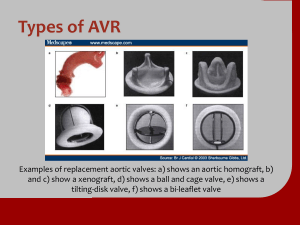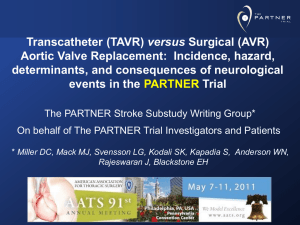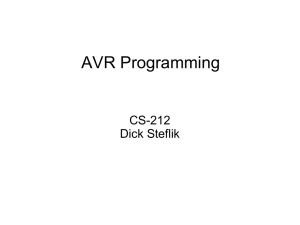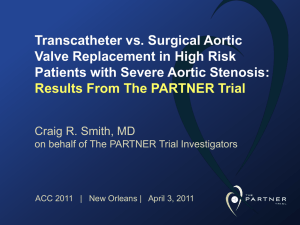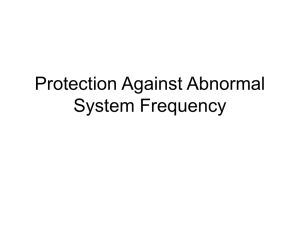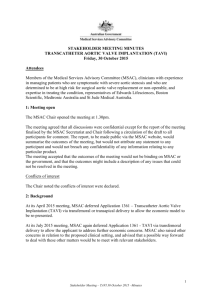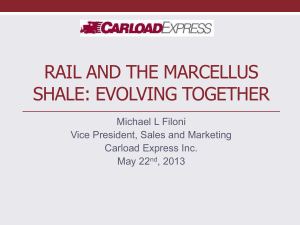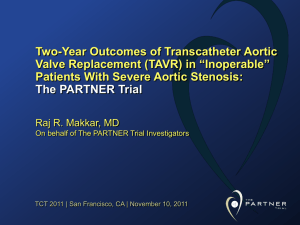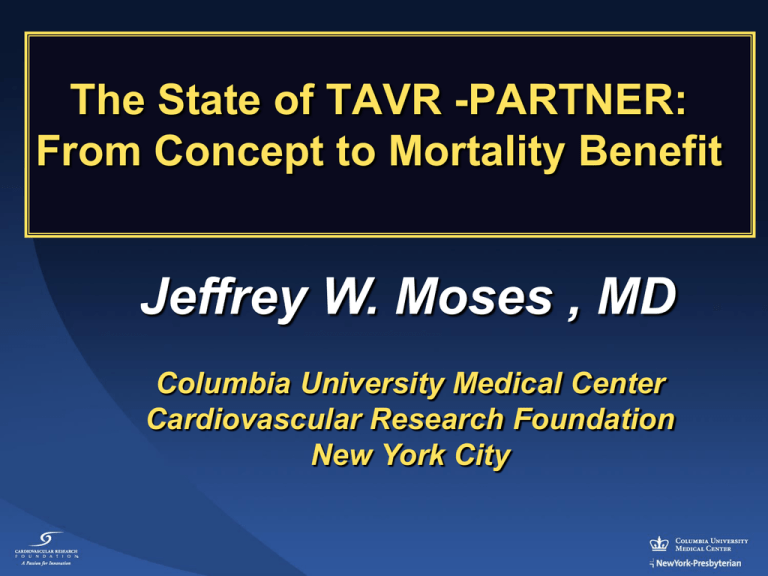
The State of TAVR -PARTNER:
From Concept to Mortality Benefit
Jeffrey W. Moses , MD
Columbia University Medical Center
Cardiovascular Research Foundation
New York City
Presenter Disclosure Information for
U Minn Grand Rounds;
Jeffrey W. Moses , M.D.
Equity Relationship:
Claret
At Least 30% of Patients with Severe
Symptomatic AS are “Untreated”!
Severe Symptomatic Aortic Stenosis
AVR
Percent of Cardiology Patients Treated
No AVR
100%
90%
80%
41
32
30
31
60
70%
45
48
60%
50%
40%
30%
68
70
69
59
55
52
Under-treatment
especially
prevalent among
patients
managed by
Primary Care
physicians
40
20%
10%
0%
Bouma
1999
1.
2.
3.
4.
Iung*
2004
Pellikka
2005
Charlson
2006
Bach
2009
Spokane
(prelim)
Vannan
(Pub.
Pending)
Bouma B J et al. To operate or not on elderly patients with aortic stenosis: the decision and its consequences. Heart 1999;82:143-148
Iung B et al. A prospective survey of patients with valvular heart disease in Europe: The Euro Heart Survey on Valvular Heart Disease. European Heart Journal
2003;24:1231-1243 (*includes both Aortic Stenosis and Mitral Regurgitation patients)
Pellikka, Sarano et al. Outcome of 622 Adults with Asymptomatic, Hemodynamically Significant Aortic Stenosis During Prolonged Follow-Up. Circulation 2005
Charlson E et al. Decision-making and outcomes in severe symptomatic aortic stenosis. J Heart Valve Dis2006;15:312-321
Potential Patients for
Transcatheter Aortic Valve Therapy
SEVERE AORTIC STENOSIS
PT. REFUSALS
BALLOON AORTIC
VALVULOPLASTY
NOT REFERRED
? ASYMPTOMATIC
AORTIC VALVE
REPLACEMENT SURGERY
HIGH-RISK
PATIENTS
TAVR 2011
Technology
Review
Early Catheter-Based AV Designs
The Davis valve (1965)
The Andersen valve (1992)
Alain Cibier Sketches (1990)
1
2
Systole
3
Diastole
PVT-Edwards
Percutaneous Heart Valve
Cribier-Edwards Device
First generation – polyurethane
Second generation – bovine pericardium
• equine pericardial valve
• stainless steel stent
• 23mm and 26mm diameters
• balloon-expandable
• AVA = 1.7-1.9 cm2
Dr. Alain Cribier
First-in-Man PIONEER
Percutaneous Transcatheter Implantation of
an Aortic Valve Prosthesis for Calcific Aortic
Stenosis
First Human Case Description
Alain Cribier, MD; Helene Eltchaninoff, MD; Assaf Bash, PhD;
Nicolas Borenstein, MD; Christophe Tron, MD; Fabrice Bauer, MD;
Genevieve Derumeaux, MD; Frederic Anselme, MD; François
Laborde, MD; Martin B. Leon, MD
Conclusions— Nonsurgical implantation
of a Nov,
prosthetic
heart
AHA;
2002
valve can be successfully achieved with immediate and midterm
hemodynamic and clinical improvement.
April 16, 2002
Sapien XT + NovaFlex Delivery System
18 Fr profile
Transcatheter AVR
Trans-apical Access Route
Transfemoral
Transapical
TAVR 2011
The
PARTNER
Trial
Published on-line September 22, 2010
@ NEJM.org and print October 21, 2010
On behalf of the Executive Committee, the Investigator Sites,
and the courageous patients who participated in the PARTNER trial!
PARTNER Study Design
Symptomatic Severe Aortic Stenosis
ASSESSMENT: High-Risk AVR Candidate
3,105 Total Patients Screened
Total = 1,057 patients
N = 699
High Risk
Inoperable
2 Parallel Trials:
Individually Powered
ASSESSMENT:
Yes
Transfemoral
Access
Transfemoral (TF)
1:1 Randomization
ASSESSMENT:
No
Transfemoral
Access
Transapical (TA)
1:1 Randomization
Yes
No
1:1 Randomization
N = 244
N = 248
N = 104
N = 103
N = 179
N = 179
TF TAVR
AVR
TA TAVR
AVR
TF TAVR
Standard
Therapy
VS
N = 358
VS
Primary Endpoint: All-Cause Mortality at 1 yr
(Non-inferiority)
Not In Study
VS
Primary Endpoint: All-Cause Mortality
Over Length of Trial (Superiority)
Co-Primary Endpoint: Composite of All-Cause Mortality
and Repeat Hospitalization (Superiority)
Executive Committee
Lars Svensson
Craig Miller
Murat Tuzcu
Craig Smith
Jeff Moses
Marty Leon
John Webb
Michael Mack
Transcatheter AVR
Hybrid OR-Cath Lab
A unique collaborative experience!
Inoperable: Patient Characteristics - 1
TAVI
Standard Rx
n=179
n=179
83.1 ± 8.6
83.2 ± 8.3
0.95
45.8
46.9
0.92
11.2 ± 5.8
12.1 ± 6.1
0.14
26.4 ± 17.2
30.4 ± 19.1
0.04
NYHA
I or II (%)
III or IV (%)
7.8
92.2
6.1
93.9
0.68
0.68
CAD (%)
67.6
74.3
0.20
Prior MI (%)
18.6
26.4
0.10
Prior CABG (%)
37.4
45.6
0.17
Prior PCI (%)
30.5
24.8
0.31
Prior BAV (%)
16.2
24.4
0.09
CVD (%)
27.4
27.5
1.00
Characteristic
Age - yr
Male sex (%)
STS Score
Logistic EuroSCORE
P value
Inoperable: Patient Characteristics - 2
TAVI
n=179
Standard Rx
PVD (%)
30.3
25.1
0.29
COPD
Any (%)
O2 dependent (%)
41.3
21.2
52.5
25.7
0.04
0.38
Creatinine >2mg/dL (%)
5.6
9.6
0.23
Atrial fibrillation (%)
32.9
48.8
0.04
Perm pacemaker (%)
22.9
19.5
0.49
Pulmonary HTN (%)
42.4
43.8
0.90
Frailty (%)
18.1
28.0
0.09
Porcelain aorta (%)
19.0
11.2
0.05
Chest wall radiation (%)
8.9
8.4
1.00
Chest wall deformity (%)
8.4
5.0
0.29
Liver disease (%)
3.4
3.4
1.00
Characteristic
n=179
P value
1ry Endpt - All Cause Mortality
Standard Rx
All-cause mortality (%)
TAVI
HR [95% CI] =
0.54 [0.38, 0.78]
P (log rank) < 0.0001
Months
Numbers at Risk
TAVI
Standard Rx
179
179
138
121
122
83
67
41
26
12
1ry Endpt - All Cause Mortality
Standard Rx
All-cause mortality (%)
TAVI
∆ at 1 yr = 20.0%
NNT = 5.0 pts
50.7%
30.7%
Months
Numbers at Risk
TAVI
Standard Rx
179
179
138
121
122
83
67
41
26
12
Clinical Outcomes at 30 Days & 1 Year
30 Days
n=179
Outcome
TAVI
1 Year
n=179
Standard
P-value
Rx
TAVI
Standard
P-value
Rx
Death
All (%)
Cardiovascular (%)
5.0
4.5
2.8
1.7
0.41
0.22
30.7
19.6
49.7
41.9
0.0004
<.0001
Repeat hospitalization (%)
5.6
10.1
0.17
22.3
44.1
<.0001
Death (all) or repeat hosp (%)
10.6
12.3
0.74
42.5
70.4
<.0001
6.7
0
1.7
5.0
1.7
0
0.6
1.1
0.03
.
0.62
0.06
10.6
0.6
2.2
7.8
4.5
0
0.6
3.9
0.04
1.00
0.37
0.18
8.4
3.9
0.12
33.0
50.3
0.001
0
0
0
0
.
.
0.6
0
0.6
0
1.00
.
Stroke or TIA
All (%)
TIA (%)
Minor stroke (%)
Major stroke (%)
Death (all) or major stroke (%)
Myocardial infarction
All (%)
Peri-procedural (%
Clinical Outcomes at 30 Days & 1 Year
30 Days
n=179
Outcome
TAVI
1 Year
n=179
Standard
P-value
Rx
TAVI
Standard
P-value
Rx
Vascular complications
All (%)
30.7
5.0
<.0001
32.4
7.3
<.0001
Major (%)
16.2
1.1
<.0001
16.8
2.2
<.0001
Acute kidney injury
Creatinine >3 mg/dL (%)
RRT (%)
0
1.1
1
1.7
1.00
1.00
1.1
1.7
2.8
3.4
0.45
0.50
Bleeding - major (%)
16.8
3.9
<.0001
22.3
11.2
0.007
BAV (%)
0.6
1.1
1.0
0.6
36.9
<.0001
Re-TAVI (%)
1.7
na
1.7
na
0
1.7
0.25
1.1
9.5
<.0001
0
0
.
1.1
0.6
0.31
New atrial fibrillation (%)
0.6
1.1
1.00
0.6
1.7
0.62
New pacemaker (%)
3.4
5.0
0.60
4.5
7.8
0.27
Cardiac re-intervention
AVR (%)
Endocarditis (%)
Arrhythmias
NYHA Class Over Time
Survivors
P < 0.0001
P < 0.0001
P < 0.0001
Percent
P = 0.68
TAVI Standard Rx
TAVI Standard Rx
Baseline
I
TAVI Standard Rx
30 Day
II
6 Month
III
IV
TAVI
Standard Rx
1 Year
Treatment
Visit
PARTNER QOL Analyses
TAVI not only
adds years to life,
but also,
adds life to years!
Cost-Effectiveness of TAVR vs. Control
Lifetime Results
$100,000 per LY
Cost = $79,837
LE = 1.59 years
ICER = $50,212/LYG
$50,000 per LY
TAVR 2011
Main
Outcomes:
High Risk
Primary Endpoint:
All-Cause Mortality at 1 Year
0.5
HR [95% CI] =
0.93 [0.71, 1.22]
P (log rank) = 0.62
TAVR
AVR
0.4
26.8
0.3
0.2
24.2
0.1
0
0
6
No. at Risk
12
18
24
Months
TAVR
348
298
260
147
67
AVR
351
252
236
139
65
All-Cause Mortality
Transfemoral (N=492)
HR [95% CI] =
0.83 [0.60, 1.15]
P (log rank) = 0.25
26.4
22.2
No. at Risk
Months
TAVR
244
215
188
119
59
AVR
248
180
168
109
56
All-Cause Mortality
Transapical (N=207)
HR [95% CI] =
1.22 [0.75, 1.98]
P (log rank) = 0.41
29.0
27.9
No. at Risk
Months
TAVR
104
83
72
28
8
AVR
103
72
68
30
9
PARTNER 1A :30 Day Outcomes (AT)
18
Transfemoral
16
14
P=0.09
12 P=0.045
10
Transapical
9.5
8.2
8
6
4
15.4
10.9
8.7
7.6
7.0
5.4
3.7
2.5
4.4
1.4
2
0
TF AVR
Death
TF AVR
Major
Stroke
TF AVR
Death
Stroke
TA AVR
Death
TA AVR
Major
Stroke
TA AVR
Death
Stroke
NYHA Functional Class
P < 0.001
Baseline
30 Days
P = 0.05
P = 0.75
Patients Surviving, %
P = 1.00
I
6 Months
II
III
IV
1 Year
Mean and Peak Gradient
As-Treated Trial Arms (mmHg)
Echo Findings
Aortic Valve Gradients
80
Peak Gradient - AVR
70
Peak Gradient TAVR
Mean Gradient - AVR
60
Mean Gradient TAVR
50
40
30
20
10
0
Baseline
TAVR
n = 327
AVR
n = 301
30 Days
TAVR
n = 287
AVR
n = 231
6 Months
TAVR
n = 246
AVR
n = 170
1 Year
TAVR
n = 227
AVR
n = 159
Paravalvular Aortic Regurgitation
P < 0.001
P < 0.001
30 Days
6 Months
1 Year
Patients, %
P < 0.001
None
Trace
Mild
Moderate
Severe
TAVR - The Future
My Rosey Prophecy
Surgery – The “PAST”
In 5-10 years, most patients
with severe AS requiring AVR
will be treated using TAVR!
TAVR – The “Future”

